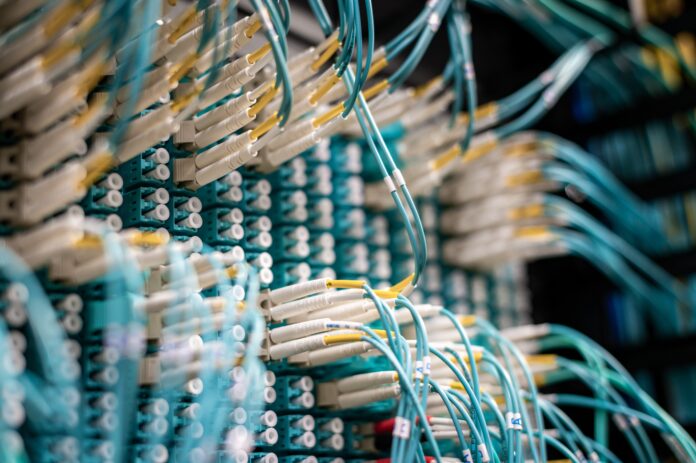Fiber optics, a cutting-edge telecommunications and data transfer advancement, has revolutionized communication and information access. It uses optical fibers, which are little strands of glass or plastic, to transport data via the transmission of light signals. Fiber optics are essential to contemporary communication networks because using light as a medium enables faster and more effective data transmission across vast distances. In this article, we will examine the fundamentals of fiber optics and delve into its different contemporary applications, emphasizing its influence on various fields and aspects of daily life.
Understanding Fiber Optics: Principles and Working
Total internal reflection is the underlying principle of fiber optics. The cladding surrounding the optical fiber’s core is meant to have a lower refractive index than the core itself. The core of the optical fiber is the most central section of the fiber. This guarantees that light signals traveling through the core are regularly reflected back into it, preventing a loss of signal intensity. The light signals, modulated to represent data, are subjected to continual reflections until they reach the other end of the fiber, turning them back into electrical signals to be processed.
Telecommunications and Internet Connectivity
Telecommunications and internet connectivity are two of fiber optics’ most important applications. Due to their improved performance, fiber optic cables have supplanted conventional copper cables in numerous applications. These cables are perfect for tying together cities, nations, and even continents since they can transmit enormous amounts of data at extraordinary rates over long distances. The internet has undergone a revolution due to fiber optics’ low latency and high bandwidth, which allow for fluid video conferencing, quick file downloads, and seamless streaming of high-definition material.
Fiber Optics in Medicine and Healthcare
Modern healthcare and medicine rely heavily on fiber optics. Endoscopy, a medical treatment that enables doctors to inspect internal organs and tissues, uses flexible fiber optic lines with cameras to send real-time images from within the body. Diagnostics have substantially improved because of this non-invasive method, and patient discomfort has decreased. Fiber optic sensors are also used to monitor patients in critical care, detect pathogens, and assess vital signs, improving healthcare results.
Industrial and Manufacturing Applications
Fiber optics has several advantages for the industrial sector. Temperature, pressure, and strain are just a few of the variables fiber optic sensors use to monitor and regulate in difficult and dangerous situations. It also increases industrial processes’ general safety and effectiveness by enabling early defect diagnosis. In addition, fiber optic networking within industrial automation systems guarantees faster and more dependable data interchange, resulting in increased production and decreased downtime.
Defense and Security Systems
Fiber optics is important to defense and security systems because it can send data safely and effectively. Military applications employ optical fibers to transmit secret data and high-definition video feeds. Fiber optics are immune to electromagnetic interference, which makes them impervious to electronic eavesdropping and guarantees secure communication between military personnel and their command centers. Fiber optic sensors are also used in critical infrastructure to monitor structural health and for perimeter security, intrusion detection, and other purposes.
Transport and Aerospace Industry
The transportation and aerospace sectors have also adopted fiber optics for various uses. For airplanes and spacecraft, lightweight and resilient fiber optic cables are utilized in the aerospace industry for avionics, communication systems, and data transfer in airplanes and spacecraft. Fiber optics helps reduce weight, which boosts overall performance and fuel efficiency. Different fiber optic cable accessories are also used with fiber optics which can easily be get from reliable online sources. Fiber optics offer high-speed communication between vehicles and infrastructure in the transportation industry, opening the way for self-driving cars and intelligent transportation systems.
Entertainment and Broadcast
Fiber optics has produced major gains for the broadcast and entertainment industries. Fiber optics is the backbone of broadcasting networks because high-definition video and audio signals can be sent over great distances without compromising quality. Fiber optics are crucial for the real-time broadcasting of live events to audiences worldwide, such as sports broadcasts and concerts. Furthermore, fiber optic technology has revolutionized gaming by enabling high-quality, lag-free online multiplayer gaming.
Conclusion
Fiber optics has unquestionably transformed modern communication and several industries. Its ability to swiftly and efficiently carry enormous volumes of data over great distances has made it important for telecommunications, internet connectivity, health, defense, transportation, and entertainment. As the technology progresses, future fiber optic applications will likely be even more ground-breaking. Fiber optic accessories will be crucial in developing and enhancing these applications as the demand for faster and more dependable data transfer keeps rising. Due to this amazing technology, our connected world will continue to take on new forms, which will also open the door for more advancements in the digital age.



